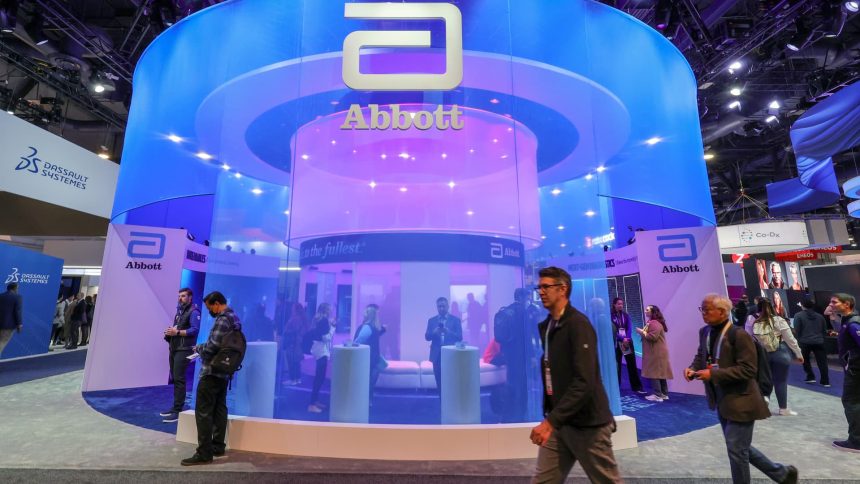All three major averages posted losses in a volatile week. The Dow Jones Industrial Average led the way down, tanking more than 500 points on Friday alone, and ended the week with a 2.7% decline. The broad-based S & P 500 index dropped 1.6%, while the tech-heavy Nasdaq Composite dipped 0.5% The cause of the decline: A slightly hotter-than-expected March consumer price index (CPI) report on Wednesday pushed up Treasury bond yields and forced investors to reconsider the number of interest-rate cuts this year from the Federal Reserve. With the economy still humming along, it’s less likely the central bank will make three cuts this year. As of Friday, the CME FedWatch Tool was indicating that the best odds are for two cuts this year, though there is still a chance we don’t see any at all. We did gain back some ground on Thursday, thanks to a weaker-than-expected March producer price index (PPI) report — and perhaps the realization that a resilient economy isn’t exactly a bad thing. Heightened tensions in the Middle East, including the possibility of Iran attacking Israel, sent stocks back down and oil prices higher. As we’ve said all year, we aren’t investing based on rate-cut expectations. We acknowledge that it influences the price action in the short term — and want to take advantage of the dislocations the market’s focus on this may cause — but possible cuts do not factor into our decisions on when, or where, to invest. We must also keep in mind that the number of rate cuts this year is the result of sustained economic strength. If the choice is between a weak economy with lower rates or a strong economy with higher rates, we’ll take the strong economy every time. Low rates may help with valuation multiples, but it’s a strong economy that leads to earnings growth and that’s what we, as long-term investors care about. Looking ahead, we’ll get a few notable macroeconomic reports to monitor, but the real driver of the action next week is earnings, including three in the portfolio. 1. Economists are estimating that March retail sales, to be released Monday, rose a seasonally adjusted 0.3% over February, according to FactSet. Retail sales don’t provide a direct read on inflation but do represent a major part of GDP (consumption represents about two-thirds of U.S. GDP). That makes retail sales a good gauge of the economy’s strength and what the Fed may do next with rates. If a soft landing — or maybe even no landing — scenario is going to play out it’s crucial that private consumption stay strong even as the economy slows. 2. Shelter costs are a major sticking point for overall inflation, which makes Tuesday’s housing starts and building permits report a key watch item. Economists are looking for 1.49 million starts and 1.515 million permits. We want to see as many starts and permits issued as possible. An increase in supply is crucial to stemming the rise in the shelter cost index. We’ll get another look at housing with the release of the March existing home sales report on Thursday. 3. The March industrial production and capacity utilization report on Tuesday should provide some insight into the state of manufacturing, including consumer and business demand. The more end-market demand, the greater the production and utilization higher up in the supply chain. 4. Earnings : Three Club names will report quarterly results for the first quarter of 2024. Morgan Stanley : The strong investment banking results in Wells Fargo’s report on Friday should bode well for Morgan Stanley. Higher equity prices, along with a rebound in M & A activity and the IPO market, are also good indicators. With that in mind, investor focus will be on the margins in wealth management and a regulatory probe into that division we learned about Thursday. Wealth management is a key source of fee-based revenue generation that investors want to see continue to grow over time, so any details from the management team will be welcome. Abbott Labs : Outside of any commentary about the ongoing baby formula litigation, we’re focused on organic growth. The company reported an 11% increase in organic growth for its underlying base business — which excludes the impact of divesting the pediatric nutrition business in China, the impact of the Cardiovascular Systems acquisition and Covid testing revenues — and we are looking for that strong momentum to continue. As noted in Friday’s Morning Meeting , we don’t expect this management team to alter guidance if the bottom line comes in stronger than expected. No matter how strong, this management team doesn’t update guidance after the first quarter. The team prefers to stay conservative and get more of the year behind it before updating. In terms of key segments, the Street is looking for a little over 6% growth in the nutrition business, 4% growth in established pharmaceuticals, and 10% growth in medical devices, Abbott’s largest division. Diagnostics is expected to be down nearly 17% versus the year-ago period as we lap Covid testing sales. Procter & Gamble : The consumer goods giant is expected to show growth in all key segments —beauty, grooming, health care, fabric care and home care, and baby care and family care — with overall organic sales rising 3.5% over last year. On Thursday, Constellation Brands showed it grew sales on volume, not by raising prices, and we expect to see the same from PG. That said, Procter & Gamble’s investments in innovation have provided it with a good deal of pricing power. More importantly, the company’s products are usually the better value, even if they come with a slightly higher sticker price versus the competition. Is management seeing more trade-downs? We’re optimistic consumers are sticking with value. Monday, April 15 8:30 a.m. ET: Retail Sales Before the bell: Goldman Sachs (GS), Charles Schwab (SCHW), M & T Bank (MTB) Tuesday, April 16 8:30 a.m. ET: Housing Starts & Building Permits 9:15 a.m. ET: Industrial Production & Capacity Utilization Before the bell: Morgan Stanley (MS) , Bank of America (BAC), UnitedHealth (UNH), Johnson & Johnson (JNJ), Bank of New York Mellon (BK), PNC Financial (PNC), Ericsson (ERIC) After the bell: United Airlines (UAL), Interactive Brokers (IBKR), JB Hunt (JBHT) Wednesday, April 17 Before the bell: Abbott Labs (ABT) , ASML Holdings (ASML), Prologis (PLD), Travelers (TRV), US Bancorp (USB), Citizens Financial (CFG) After the bell: Alcoa (AA), Kinder Morgan (KMI), CSX (CSX), Discover Financial (DFS), Equifax (EFX) Thursday, April 18 8:30 a.m. ET: Initial Jobless Claims 10:00 a.m. ET: Existing Home Sales Before the bell: Nokia (NOK), Alaska Air (ALK), DR Horton (DHI), KeyCorp (KEY), Blackstone BX), Elevance Health (ELV), Ally Financial (ALLY), Marsh & McLennan (MMC), Snap-On (SNA), Genuine Parts (GPC), ManpowerGroup (MAN) After the bell: Netflix (NFLX), Intuitive Surgical (ISRG), PPG Industries (PPG) Friday, April 19 Before the bell: Procter & Gamble (PG) , SLB (SLB), Huntington Bancshares (HBAN), Regions Financial, American Express (AXP) (See here for a full list of the stocks in Jim Cramer’s Charitable Trust.) As a subscriber to the CNBC Investing Club with Jim Cramer, you will receive a trade alert before Jim makes a trade. Jim waits 45 minutes after sending a trade alert before buying or selling a stock in his charitable trust’s portfolio. If Jim has talked about a stock on CNBC TV, he waits 72 hours after issuing the trade alert before executing the trade. THE ABOVE INVESTING CLUB INFORMATION IS SUBJECT TO OUR TERMS AND CONDITIONS AND PRIVACY POLICY , TOGETHER WITH OUR DISCLAIMER . NO FIDUCIARY OBLIGATION OR DUTY EXISTS, OR IS CREATED, BY VIRTUE OF YOUR RECEIPT OF ANY INFORMATION PROVIDED IN CONNECTION WITH THE INVESTING CLUB. NO SPECIFIC OUTCOME OR PROFIT IS GUARANTEED.
All three major averages posted losses in a volatile week. The Dow Jones Industrial Average led the way down, tanking more than 500 points on Friday alone, and ended the week with a 2.7% decline. The broad-based S&P 500 index dropped 1.6%, while the tech-heavy Nasdaq Composite dipped 0.5%
Read the full article here
News Room




